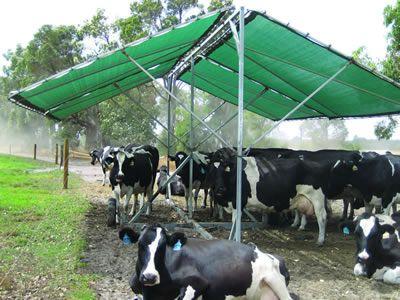Raising Livestock: Keeping your livestock cool this summer

Keeping livestock cool in the summertime is vitally important, not only for the sake of comfort but also to prevent heat stress. If heat stress sets in, livestock productivity and/or performance decreases while the chances of heat stroke increase. What’s more, heat stress is very difficult to combat once it begins, so preventative measures are of the utmost importance. Follow the steps below to stay ahead of heat stress and keep livestock cool and happy all summer long.
Cold, fresh water
Water. It’s the single most important thing for livestock in hot weather. But stagnant, sun-warmed water from traditional tanks not only poses health risks from built-up bacteria and debris, it doesn’t cool the animals down and doesn’t entice them to drink. Instead of traditional waterers, automatic livestock waterers like the ones we manufacture here at Nelson provide a constant supply of cold, fresh water that cools the animals from the inside out and keeps them drinking through the hot summer months.
Please note: You may want to add electrolytes to your livestock’s water supply from time to time. Not only are electrolytes extremely conducive to hydration, but many of them have flavorings that further entice your stock to drink.
Shade
Along with water, shade is the most important provision in summertime. Always ensure that your livestock – be they horses, cattle, pigs, goats, alpacas, or chickens – have easy and adequate access to shade. Ideally, shade is provided by open-air sheds that allow a nice breeze to pass through, but if all you have is a traditional barn, open any and all windows and vents and be sure to amply stock it with fans (below).
Fans
Stock any indoor environments with utility fans from your local farm supply store. For cattle and other large animals, only large utility fans possess the size and power needed for adequate cooling. For chickens and smaller livestock, smaller consumer-grade fans will work, but be sure they face the livestock directly and seem to be doing their job (if you see panting and/or wing-flapping, upgrade to a higher-power fan). With chickens and other winged stock, be sure that the fans are set at a safe enough distance that the animals won’t catch feathers in the blades (mounting fans on the ceiling is often a good choice).
Please note: Never – under ANY circumstance – subject your livestock to air conditioning. Air conditioning is an enormous health hazard to livestock, for not only can it chill them, but it disrupts natural bio-patterns and can leave the animals with zero defenses when they are exposed to heat. Let your stock adjust naturally to the season, while doing your best to keep them comfortable.
Spraying systems
Large livestock operations will run misting systems through their barns and facilities to keep stock cool. For smaller operations, single mist-ers mounted on fans are often quite effective. Sprinklers also work quite well for outdoor pastures – just make sure they’re situated so that animals can’t step on them or get tangled up in hoses.
Please note: You may be inclined to let your stock have access to ponds or wet areas during the summer months, but this is not advisable. First of all, all kinds of health risks lurk in wet areas – anything from disease-causing bacteria to snapping turtles and snakes! Furthermore, standing in water can lead to infected hooves, and if livestock defecate in the pond or wet area, it can contaminate the ground water supply. Keep your livestock away from bodies of water, and let them enjoy sprinklers instead!
Baths
For stock that can be haltered, pamper them with nice, cool baths (especially after workouts). Baths can be so cooling, however, that you have to be careful not to send your animals into temperature shock. Always start by hosing down the legs, cooling them before moving up to the body and the areas closest to the heart (hose the chest last). Be sure to let the animal stand until dry – if turned out wet many animals will roll on the ground to dry themselves, but this coats them with a layer of dirt that collects heat and, of course, makes them dirty all over again.
Signs of heat stress
Take the above precautions and you shouldn’t have to worry about heat stress, but that doesn’t mean you shouldn’t always be on the lookout. For horses and other animals with sweat glands, watch for profuse sweating in periods of inactivity. For animals such as cattle and hogs who don’t sweat, look for open-mouth breathing and panting. In all animals, be especially watchful for signs of incoordination, disorientation, and trembling. If these symptoms set in, heat stroke is just around the corner and you need to cool the animal down immediately with a cold bath and/or ice packs.
By and large, precautionary measures are enough to prevent against heat stress. Take the right steps at the start of summer, and you and your livestock will be able to enjoy the summer weather all season long.
Related news
 Automatic Livestock Waterers: Preparing for Winter
Automatic Livestock Waterers: Preparing for Winter Water is the most essential nutrient for livestock. In the summer time, troughs need cleaned and refilled every day.
 Preparing Your Livestock for Cold Weather – Your Complete Guide
Preparing Your Livestock for Cold Weather – Your Complete Guide With the winter storm that swept through the country recently, winter came suddenly and ferociously. And even though my family has farmed for generations
 Raising Livestock: How to Raise Premium Livestock for Making Money
Raising Livestock: How to Raise Premium Livestock for Making Money You may remember the old Wendy’s ad: “Where’s the beef?” If you’re considering raising livestock for a living, you need to do your research, make a commitment